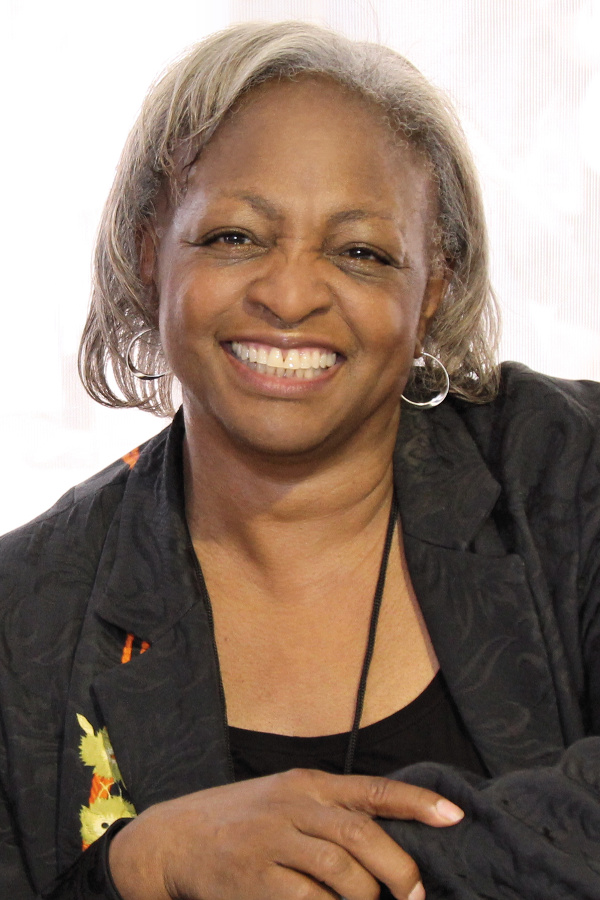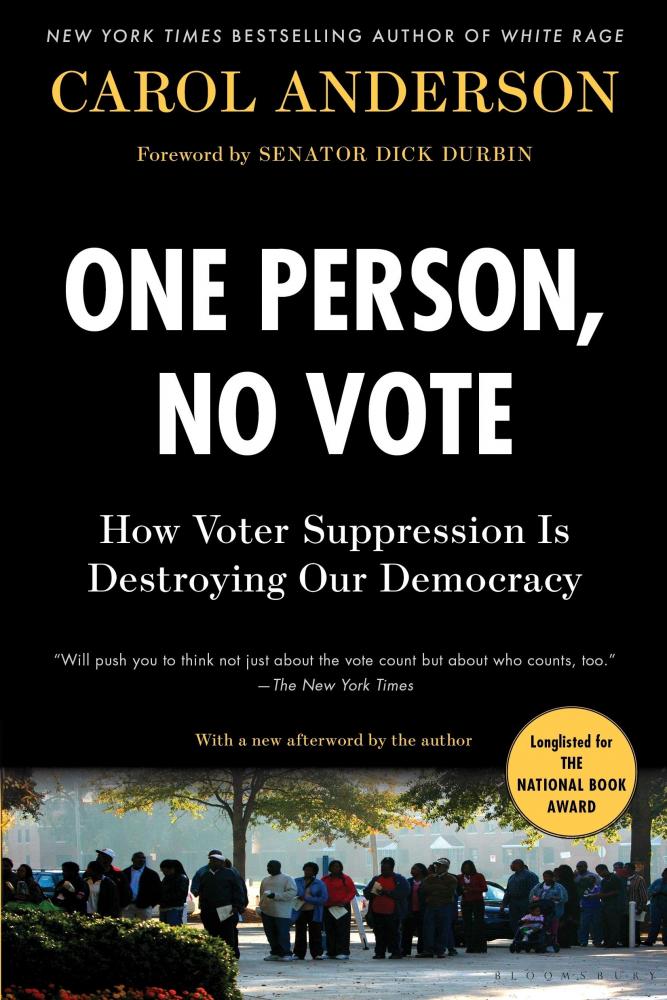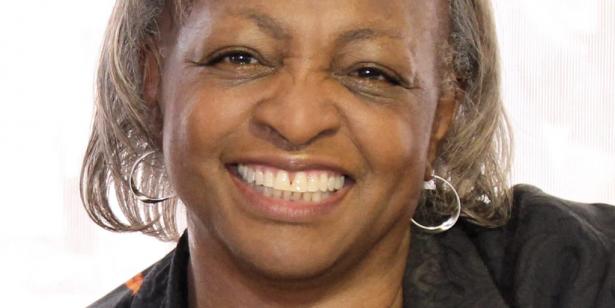Janine Jackson: Heritage Foundation co-founder Paul Weyrich’s statement at that Ronald Reagan rally in 1980, “I don’t want everybody to vote; elections are not won by a majority of people,” is as clear a picture as one needs that voter suppression is seen by many powerful Republicans as a legitimate tool for moving the country in the direction they choose. Taken seriously, this goes beyond partisanship, upending decades of what many understood to be the country’s driving political project: the expansion of participation in the democratic process.
If only ever thinly veiled, Republican voter suppression is out of the bag now, as, in the wake of a disastrous Supreme Court decision, state after state moves to commit what our guest calls “bureaucratic violence” against overwhelmingly black, brown and low-income communities seeking to exercise their fundamental rights.
Corporate media have got just beyond balancing evidence of voter suppression with spurious claims of voter fraud, but perhaps not so far as drawing a coherent picture of the overall suppressive project, so that each particular iteration—an ID requirement here, an inaccessible polling place there—can be understood in context. Such a vision would make even more clear that what’s at stake in 2020 goes well beyond the White House.
Here to help us see what’s going on is Carol Anderson, Charles Howard Candler Professor of African-American Studies at Emory University, and the author of, among other titles, White Rage: The Unspoken Truth of Our Racial Divide, and most recently, One Person, No Vote: How Voter Suppression Is Destroying Our Democracy, out now from Bloomsbury. She joins us now by phone from Atlanta. Welcome to CounterSpin, Carol Anderson.
Carol Anderson: Hi, thank you so much for having me.
JJ: For many people, “democracy” is just the label you put on the US, because of the mechanism of voting. But democracy-making is ongoing work. I wonder, could you just talk about what you see when you look around the current landscape that represents what you’ve called “bureaucratic violence” on folks’ right to vote?

Carol Anderson: “All of these things have the aura of trying to protect democracy, trying to protect the integrity of the ballot box, but it’s based on the lie of massive rampant voter fraud.”
CA: Absolutely. And that bureaucratic violence: I use that term because, often when we think about disfranchisement, we think about it in terms of the violence on the Edmund Pettus Bridge in Selma in 1965. But bureaucratic violence, that’s the array of policies that have been pooled together to figure out, “How do we get around the 15th Amendment, while targeting those that the 15th Amendment was designed to protect?”
The 15th Amendment of the Constitution says that the right to vote shall not be abridged “on account of race, color or previous condition of servitude.” And what we saw originally was the Mississippi Plan of 1890 that figured out how to get around it with poll taxes and literacy tests. What we’re seeing now is what I’m calling “Jim Crow 2.0,” for want of a better term: these states doing things like voter ID laws, and poll closures, and voter roll purges. And all of these things have the aura of trying to protect democracy, trying to protect the integrity of the ballot box, but it’s based on the lie of massive rampant voter fraud.
And when I say “lie,” I mean that Justin Levitt, a law professor out of California, found that between 2000 and 2014, there were a billion votes cast in elections, and there were only 31 cases of voter impersonation fraud.
JJ: Right.
CA: Out of 1 billion votes. So that’s the lie of massive rampant voter fraud, about two cases per year. But from that, we get the kind of voter ID laws that say, “Oh, everybody’s got an ID.” But what these state legislatures have done is to identify the types of IDs that whites have, that African Americans don’t have, that Latinos don’t have, that Native Americans don’t have—and then to privilege the ones that whites have, while making it seem fair and across the board.
In fact, it is anything but; it is what led the Fourth Circuit in North Carolina to say that the North Carolina state legislature had targeted African Americans “with almost surgical precision” with its array of laws, including those voter ID laws.
And what we’re seeing as well are voter roll purges. We saw in Ohio, another massive purge of several hundred thousand. And because that list was made public, it had a 20% error rate, at least, including the head of the League of Women Voters. These targeted hits, the voter roll purges, what they’re designed to do, again, it’s supposed to sound reasonable: “You gotta keep the voter rolls cleaned up.” So if people die, they shouldn’t be on the list; if people move out of state, they shouldn’t be on the list. We get that.
But what these states have done is to target people that they say haven’t voted regularly, although the National Voter Registration Act, the “Motor Voter Law” of 1993, specifically says you cannot remove people simply because they haven’t voted. You don’t lose your right to vote simply because you haven’t voted, but that’s what these states have done. And the US Supreme Court, last year in June, approved that, because this is the same Supreme Court that gave us the Shelby County v. Holder decision that gutted the Voting Rights Act.
So there are an array of policies, including poll closures—because we know the further you remove a polling place, for instance, from the black community, voter turnout goes down, because it has to deal with distance and access to transportation. So if you make the polling place inaccessible—here in Georgia, for instance, they tried to move the polling place for the black community in Sparta 17 miles away. That’s inaccessible. On a work day!
JJ: And all these things are kind of you say, “wrapped in the veneer of law.” So if you’re not paying attention, you can almost think it makes sense: “Oh, we’re not saying they can’t vote because they’re black; we’re saying they don’t have the right form,” you know, “It’s not because they’re young, it’s because they can’t show residency,” you know, “It’s not that they have a disability, it’s that we can’t get a polling place in that particular…” It’s always just that one level of indirect, that they think they’re fooling you that it’s not targeted in some way.
CA: Exactly. And because it’s what I call this “bureaucratic violence,” we don’t see it, and so it doesn’t create the sense of urgency. But from 2014 to 2016, the Brennan Center identified that 16 million Americans were purged from the voter rolls. Sixteen million. That is silent civic death.
JJ: In your piece from last November in the Guardian, “The Five Ways Republicans Will Crack Down on Voting Rights in 2020,” you also list judges and the role of the courts, because they’ve got a role to play here, too, right?
CA: Oh, absolutely. One of the things that we’ve seen, for instance, is that the US Senate has been confirming these right-wing judges who cannot even get their mouths fixed to say that the Brown decision was appropriately decided. These are judges who do not believe in civil rights. These are judges who do not believe in voting rights. These are the judges who do not believe in environmental rights. These are the judges who do not believe in women’s rights.
And the Republicans in the Senate have been pushing these judges through, with no real vetting whatsoever. So several have gone through, more than ever before, that the American Bar Association has ruled as being unqualified.
And so we have unqualified federal judges with lifetime appointments on the bench. And so what happens then is, as these cases—civil society, the NAACP Legal Defense Fund, the ACLU, the NAACP, the League of Women Voters, they have been suing the states for these voter suppression laws and how discriminatory they are. But as these cases go up, they’re hitting these judges, these judges who do not believe in voting rights.
And that is why this election of 2020 is so crucial. Because if we have a federal judiciary just loaded down with those who do not believe in basic civil rights, do not believe in the rights guaranteed in the Constitution. Whew….
JJ: Yeah.
CA: Then we are going to be back to where we were after Reconstruction, when that Supreme Court basically gutted the 14th and 15th Amendments, and skewered the 13th Amendment, that has badges of servitude. And it took about 100 years and a civil rights movement to undo the damage coming out of Reconstruction with that Supreme Court. And that’s where we are headed again, unless we stop it.

JJ: One review said that One Person, No Vote “seems to have been written from a state of emergency.” That sounds like a fair assessment, and like an appropriate one. Let’s talk a bit about resistance. As you note in the book, there is—well, first of all, there’s awareness. Not everyone is falling for this “protecting the integrity of the process” line. But also there’s resistance, and some states even pushing back and making it easier to vote, right; that’s happening, too?
CA: Oh, absolutely, absolutely. So the resistance, I mean, you’re getting incredible organizing in local communities. You’re seeing organizations, like I’ve mentioned before as well as Fair Fight, in there mobilizing, organizing, suing.
And you do have states that have the leadership that actually believes in democracy. So they are doing same-day voter registration, they are doing automatic voter registration. One of the things that they did in California, following Oregon’s lead, what California did was to say, “Yes, we’re going to do automatic voter registration, but we’re going to also preregister 16- and 17-year-olds, so that when they turn 18, they are automatically registered to vote.” This broadening of the electorate, this sense that American citizens are engaged, invested in this nation, that is not a bad thing.
JJ: Right.
CA: But when you have a platform, and I love the Paul Weyrich quote that you used, when he said, “Oh, all you ‘goo goo’ folks, you believe in good government. Well, I don’t, because I don’t want everybody to vote, because, frankly, our leverage goes up when the voting population goes down.”
So you have a number of states moving in one direction, and a number of states moving in the other. One of the things that we saw in 2018, for instance, were a series of ballot initiatives, citizen-led ballot initiatives. The one in Florida, for instance: Florida had permanent felony disfranchisement, for all intents and purposes.
So you had 1.7 million people in Florida who could not vote because they had a felony conviction. And this is after they have served their time, they have paid their debt to society, and they were suffering what is called civic death. And the citizens got together, and I think something like 65% voted for Amendment 4 that provided a pathway for the right to vote for 1.4 million of those returning citizens. That is amazing and incredible. And of course, the Republican legislature and Republican governor have worked really hard to undermine that citizens’ initiative.
In Michigan, you had a ballot initiative to have a nonpartisan redistricting commission to get rid of the extreme partisan gerrymandered districts, and to realize that extreme partisan gerrymandering—where you end up with these really weirdly drawn congressional districts that are designed to create additional power in one set of communities and diminish the power in another—and said, “No, this is about one person, one vote; this is about equal representation.”
And this is the thing that I think consistently gets missed: Americans will fight back.
JJ: Right.
CA: And that’s what we’re seeing here.
JJ: You write in White Rage about the Chicago Defender, the black newspaper that was crucial in the Great Migration of black people from the South to the North. And your piece, in the Washington Post in the summer of 2014, I think, reoriented countless readers’ understanding of events, in Ferguson and elsewhere, from black protest to white rage. Dick Durbin made Senate Democrats read that essay, I understand, and had you address their conference.
Media can be powerful, for good and ill. What do you see as the actual or potential role for journalism, with regard to this issue of voter suppression? What could they be doing more of or less of or none of?
CA: I think they need to understand the patterns. Because this isn’t just this one thing of, “Oh, there weren’t enough voting machines in Gwinnett County, the lines were four-and-a-half hours long because somebody forgot the power cords”; or “They were long in Fulton County because there were four machines, and there should have been 20.”
JJ: Right.
CA: But to see the overall pattern, and continuing to hammer it home, about what is at stake in this democracy—it requires good investigative journalism, it requires going beyond the soundbite, it requires a clarion call: This nation is in danger.
When you think about the efforts that it’s taken. In 2016, one of the things that led, for instance, to me writing One Person, No Vote was, after the election in 2016, there were too many pundits, too many newspapers, too many outlets, saying, “Well, you know, black people just didn’t show up.”
JJ: Right.
CA: “Because they weren’t feeling Hillary, she just doesn’t have the magic of Obama, and they just stayed home.” And that inability to connect at least two dots, that this was the first presidential election in 50 years without the protection of the Voting Rights Act, and that we have a slew of voter ID laws, poll closures, voter roll purges, that contributed greatly to that.
That’s what we need: the ability to think critically, connect the dots, do the work, sound the clarion call.
JJ: I think sometimes media make it seem partisan; they’re so used to that Republican vs. Democrat frame, that even when you hear a Republican say, “We don’t want certain people to vote”—well, they don’t want an election that includes those folks, because they don’t want a politics that includes those folks. And I don’t even see media saying, “This is what they want, is to exclude certain people from the whole society, from the whole decision-making process.” It’s not like, “Oh, they just want to win this one election this one time.”
CA: Exactly. Exactly. And the thing is, is that what we should understand in a democracy is that you lay out your policies, you lay out your plans, you lay out your program, your platform, and if it resonates with the people, then you win the election. When your policies don’t resonate, then there’s something wrong with your policies. But when the Republicans looked up and saw that the further they moved to the right, the further they were away from Americans wanting—for instance, you look at the polls, Americans want to have access to quality healthcare.
JJ: Right.
CA: Americans want to have semiautomatic, military-grade weaponry out of the hands of civilians. Americans want strong, effective responses to climate change and environmental degradation. And we haven’t got any movement on that, because those constituencies have been electorally silenced.
JJ: Let me just ask, finally, part of moving forward involves vision. In the US, on race, of course, that has to include understanding history, and the past that isn’t even past. But I like where you talk about imagining. Imagine if Reconstruction had actually honored the citizenship of 4 million freed people. Imagine if Brown v. Board of Ed were really honored.
I mean, keeping our “eyes on the prize” is more than a slogan, it’s actually a political requirement—right?—to have a vision of where we want to go.
CA: Exactly. Knowing where we want to go. And that is a broad, inclusive, vibrant democracy. It will get noisy. And that’s OK. But as long as we’re moving forward, thinking about how we honor our children, how we honor our communities, how we honor the rights of all of us, citizens and immigrants. How we do this work, how do we make this place better?
When that’s the vision—oh!
And when you think about it, when the US does its kind of “history thing,” the moments that it’s proudest of are when it has stood up against oppression and tyranny. So why not make that not so episodic? Why not make that the long-term theme?
JJ: We’ve been speaking with Carol Anderson, Charles Howard Candler Professor of African-American Studies at Emory University. Her books include White Rage, the Unspoken Truth of Our Racial Divide and, most recently, One Person, No Vote: How Voter Suppression Is Destroying Our Democracy; that’s out now from Bloomsbury. Carol Anderson, thank you so much for joining us this week on CounterSpin.
CA: Oh, thank you so much. This was a wonderful conversation.


Spread the word